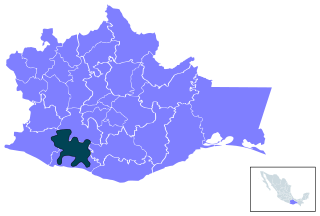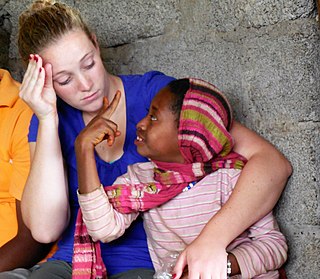Related Research Articles

Sign languages are languages that use the visual-manual modality to convey meaning, instead of spoken words. Sign languages are expressed through manual articulation in combination with non-manual markers. Sign languages are full-fledged natural languages with their own grammar and lexicon. Sign languages are not universal and are usually not mutually intelligible, although there are also similarities among different sign languages.
Martha's Vineyard Sign Language (MVSL) was a village sign-language that was once widely used on the island of Martha's Vineyard from the early 18th century to 1952. It was used by both deaf and hearing people in the community; consequently, deafness was not a barrier to participation in public life. Deaf people who signed Martha's Vineyard Sign Language were extremely independent.
Oralism is the education of deaf students through oral language by using lip reading, speech, and mimicking the mouth shapes and breathing patterns of speech. Oralism came into popular use in the United States around the late 1860s. In 1867, the Clarke School for the Deaf in Northampton, Massachusetts, was the first school to start teaching in this manner. Oralism and its contrast, manualism, manifest differently in deaf education and are a source of controversy for involved communities. Oralism should not be confused with Listening and Spoken Language, a technique for teaching deaf children that emphasizes the child's perception of auditory signals from hearing aids or cochlear implants.
Mayan Sign Language is a sign language used in Mexico and Guatemala by Mayan communities with unusually high numbers of deaf inhabitants. In some instances, both hearing and deaf members of a village may use the sign language. It is unrelated to the national sign languages of Mexico and Guatemala, as well as to the local spoken Mayan languages and Spanish.
Home sign is a gestural communication system, often invented spontaneously by a deaf child who lacks accessible linguistic input. Home sign systems often arise in families where a deaf child is raised by hearing parents and is isolated from the Deaf community. Because the deaf child does not receive signed or spoken language input, these children are referred to as linguistically isolated.
Japanese Sign Language, also known by the acronym JSL, is the dominant sign language in Japan and is a complete natural language, distinct from but influenced by the spoken Japanese language.
Indo-Pakistani Sign Language (IPSL) is the predominant sign language in the subcontinent of South Asia, used by at least 15 million deaf signers. As with many sign languages, it is difficult to estimate numbers with any certainty, as the Census of India does not list sign languages and most studies have focused on the north and urban areas. As of 2021, it is the most used sign language in the world, and Ethnologue ranks it as the 151st most "spoken" language in the world.
A contact sign language, or contact sign, is a variety or style of language that arises from contact between deaf individuals using a sign language and hearing individuals using an oral language. Contact languages also arise between different sign languages, although the term pidgin rather than contact sign is used to describe such phenomena.
Manually coded languages (MCLs) are a family of gestural communication methods which include gestural spelling as well as constructed languages which directly interpolate the grammar and syntax of oral languages in a gestural-visual form—that is, signed versions of oral languages. Unlike the sign languages that have evolved naturally in deaf communities, these manual codes are the conscious invention of deaf and hearing educators, and as such lack the distinct spatial structures present in native deaf sign languages. MCLs mostly follow the grammar of the oral language—or, more precisely, of the written form of the oral language that they interpolate. They have been mainly used in deaf education in an effort to "represent English on the hands" and by sign language interpreters in K-12 schools, although they have had some influence on deaf sign languages where their implementation was widespread.

The Chatinos are an indigenous people of Mexico. Chatino communities are located in the southeastern region of the state of Oaxaca in southern central Mexico. Their native Chatino language are spoken by about 23,000 people, but ethnic Chatinos may number many more. The Chatinos of San Juan Quiahije call themselves neq-a tnya-j and their language Chaq-f tnya-b.

Chatino is a group of indigenous Mesoamerican languages. These languages are a branch of the Zapotecan family within the Oto-Manguean language family. They are natively spoken by 45,000 Chatino people, whose communities are located in the southern portion of the Mexican state of Oaxaca.
Korean Sign Language or KSL is a sign language used for deaf communities of South Korea. It is one of two official languages in the country, alongside Korean.
Singapore Sign Language, or SgSL, is the native sign language used by the deaf and hard of hearing in Singapore, developed over six decades since the setting up of the first school for the Deaf in 1954. Since Singapore's independence in 1965, the Singapore deaf community has had to adapt to many linguistic changes. Today, the local deaf community recognises Singapore Sign Language (SgSL) as a reflection of Singapore's diverse linguistic culture. SgSL is influenced by Shanghainese Sign Language (SSL), British Sign Language(BSL), Australian Sign Language(Auslan), American Sign Language (ASL), Signing Exact English (SEE-II) and locally developed signs.

Deaf education is the education of students with any degree of hearing loss or deafness. This may involve, but does not always, individually-planned, systematically-monitored teaching methods, adaptive materials, accessible settings, and other interventions designed to help students achieve a higher level of self-sufficiency and success in the school and community than they would achieve with a typical classroom education. There are different language modalities used in educational setting where students get varied communication methods. A number of countries focus on training teachers to teach deaf students with a variety of approaches and have organizations to aid deaf students.

Susan Goldin-Meadow is the Beardsley Ruml Distinguished Service Professor in the Departments of Psychology, Comparative Human Development, the college, and the Committee on Education at the University of Chicago. She is the principal investigator of a 10-year program project grant, funded by the National Institute of Child Health and Human Development, designed to explore the impact of environmental and biological variation on language growth. She is also a co-PI of the Spatial Intelligence and Learning Center (SILC), one of six Science of Learning Centers funded by the National Science Foundation to explore learning in an interdisciplinary framework with an eye toward theory and application. She is the founding editor of Language Learning and Development, the official journal of the Society for Language Development. She was President of the International Society for Gesture Studies from 2007–2012.

Deaf studies are academic disciplines concerned with the study of the deaf social life of human groups and individuals. These constitute an interdisciplinary field that integrates contents, critiques, and methodologies from anthropology, cultural studies, economics, geography, history, political science, psychology, social studies, and sociology, among others. The field focuses on the language, culture, and lives of the deaf from the social instead of the medical perspective.
A village sign language, or village sign, also known as a shared sign language, is a local indigenous sign language used by both deaf and hearing in an area with a high incidence of congenital deafness. Meir et al. define a village sign language as one which "arise[s] in an existing, relatively insular community into which a number of deaf children are born." The term "rural sign language" refers to almost the same concept. In many cases, the sign language is known throughout the community by a large portion of the hearing population. These languages generally include signs derived from gestures used by the hearing population, so that neighboring village sign languages may be lexically similar without being actually related, due to local similarities in cultural gestures which preceded the sign languages. Most village sign languages are endangered due to the spread of formal education for the deaf, which use or generate deaf-community sign languages, such as a national or foreign sign language.
Emiliana Cruz is a contemporary linguistic anthropologist. She received her doctorate in linguistic anthropology from University of Texas at Austin and currently teaches at CIESAS-CDMX. She is the co-founder of the Chatino Language Documentation Project.
Karen Denise Emmorey is a linguist and cognitive neuroscientist known for her research on the neuroscience of sign language and what sign languages reveal about the brain and human languages more generally. Emmorey holds the position of Distinguished Professor in the School of Speech, Language, and Hearing Sciences at San Diego State University, where she directs the Laboratory for Language and Cognitive Neuroscience and the Center for Clinical and Cognitive Neuroscience.
References
- 1 2 3 Lynn Hou and Kate Mesh, 2013, Negation in Chatino Sign Archived 2016-03-04 at the Wayback Machine , Theoretical Issues in Sign Language Research (TISLR 11), University College, London, July 2013
- ↑ Erard, Michael (April 17, 2014). "The Discovery of a New Language Can Help Explain How We Communicate". Al Jazeera.
- ↑ Deaf researcher studies emergence of new signed language in Mexico, The Daily Texan, University of Texas at Austin, 2014 Feb 26.